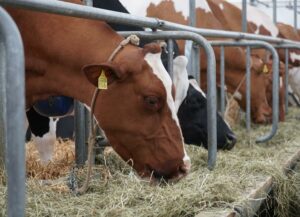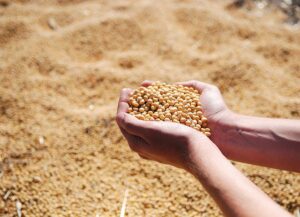Fernando Diaz
Phosphorus is an essential macromineral involved in several biological processes such as bone mineralization, energy transition, and acid-base buffer systems. During lactation, the NRC 2001 guidelines recommends to feed diets with 0.3 – 0.4% of phosphorus in a dry matter (DM) basis.
In general, in intensive dairy production systems, feeding feed ingredients with medium (cereal and cereal co-products) and high concentration of phosphorus (soybean meal) is normally enough to meet cow’s phosphorus requirement, thus, it is not necessary to supplement mineral phosphorous (phosphates).
Nonetheless, cow phosphorous requirement during the last trimester of gestation increases drastically. It has been reported that phosphorus accretion in fetus (fetal fluids and membranes) and uterine tissues increases from 1.9g/day at 190 to 5.4g/d at 280 days of gestation, respectively. For this reason, phosphorus deficiency and hypophosphatemia incidence in dairy cows are more common during the transition period.
A study from Utrecht University, the Netherlands (Grünberg et al., 2019) determined the effects of feeding low phosphorus diets on transition cows. During 8 weeks, from 4 weeks before to 4 weeks after the expected day of calving, the researchers fed close-up and fresh diets with either deficient (18 cows) or adequate (18 cows) phosphorus content. In close-up and fresh cow deficient diets, phosphorous contents were 0.15 and 0.20% on a dry matter (DM) basis, respectively. Adequate diets were supplemented with monosodium phosphate to have a phosphorus concentration of 0.28% DM in the close-up and 0.44% DM in the fresh diet.
Cows receiving the adequate phosphorus diets showed normal concentrations in blood plasma (4 – 8 mg P/dL) throughout the entire experimental period. On the other hand, the deficient diets were effective in inducing and sustaining pronounced hypophosphatemia. In cows fed with these diets, phosphorous concentration in plasma declined continuously from 4.0 mg/dL (5 weeks before calving) to 1.5 mg/dL at parturition, and remained at this level during the fresh period.
Feeding deficient phosphorus diets during the transition period affected production performance and cow health. Feed intake and milk production were lower in cows fed the diets with deficient phosphorus supply. Additionally, three cows (17%) in the deficient group developed postparturient hemoglobinuria, a disorder associated with hypophosphatemia in fresh dairy cows. Surprisingly, the authors did not observe clinical effects of phosphorous deficiency before calving.
Interestingly, after the experimental period when the fresh cows receiving a low phosphorous diet where fed a diet with adequate supply, phosphorous concentration in plasma increased rapidly returning to adequate levels in less than 2 weeks (above 4 mg/ dL). This indicates the efficacy of oral phosphorous supplementation to treat hypophosphatemia.
In conclusion, dairy nutritionists and farmers sometime overlook phosphorous concentration in transition diets. Dry matter intake is limited during the peripartum period. Therefore, keeping adequate content of phosphorous (0.3 – 0.4% DM) in the diets is needed to assure cow performance and health at the beginning of the lactation.
References
- W. Grünberg, P. Scherpenisse, I. Cohrs, L. Golbeck, P. Dobbelaar, L. M. van den Brink, and I. D. Wijnberg. 2019. Phosphorus content of muscle tissue and muscle function in dairy cows fed a phosphorus-deficient diet during the transition period. J. Dairy Sci. 102:4072–4093.
- NRC. 2001. Nutrient Requirements of Dairy Cattle. 7th rev. ed. Natl. Acad. Sci., Washington, DC.
© 2020 Dairy Knowledge Center. All Rights Reserved.











